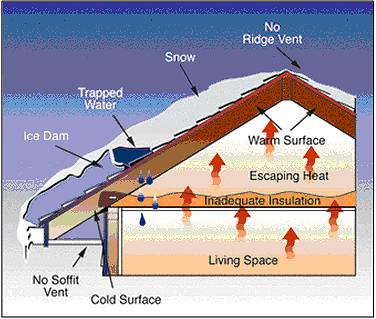Scrub Hub: What are ice dams and how big of a problem are they for your roof? (pretty big)
For many people, the term ice dam conjures a specific image: A buildup of frozen crystals across a river or stream. For those who've have had roof leaks during the winter, a different image come to mind.
That’s the kind of ice dam we will be talking about for this story. Now, some of you may still be scratching your heads — but don’t worry, we’ll here's the deal.
The two premises are actually much the same. There is a build-up of ice that keeps water behind it. Depending where that dam forms, and when it thaws, it can cause big problems.
Scrub Hub: What is being done in Indiana to bring back American chestnut trees?
For this edition of the Scrub Hub we will be answering a couple questions about the home version of ice dams. First, we will look at precisely what they are and what causes them. Even more, we will try to determine if the risks of and problems from ice dams are getting worse.
To help find the answers, we looked at information from the National Weather Service and spoke with Indiana’s state climatologist.
Short answer: Ice dams may be flooding your home
When it comes to homes, an ice dam is a ridge of ice that forms at the edge of a roof. At its core, these dams are formed by uneven surface temperatures across your roof.
Heat loss from your house, precipitation and outside temperatures all can interact to form ice dams. Heat escaping through the roof will often melt snow or ice on the surface, which will then flow down to the edge of the roof. As it reaches the eave of the house that extends past the walls, the temperature is much cooler, which can cause the water to freeze, according to the National Weather Service.
This is what creates the ice dam. And an ice dam creates problems.

Water that backs up behind the dam remains liquid and will find cracks or openings in the roof coverings. From there, it can get under your shingles and leak through the roof into your home. This can cause damage to walls, ceilings, insulation and more.
The dam can grow as it is fed by more liquid above it, and the problem perpetuates. Ice dams can be further exacerbated by shingles that roll up at the edge or filled gutters that further trap the water.
Long answer: The problem might get worse
Now some of you may be thinking to yourself: We don’t get as much snow these days in Central Indiana, so what’s the problem? But that actually is the problem.
In decades past, we used to see more snow in Indiana. We also used to see more consistently cold temperatures throughout the winter that hovered around and below freezing at 32 degrees Fahrenheit.
In recent years, however, our winters have been marked by more wet and rainy precipitation as well as temperatures that fluctuate much more rapidly and over a wider range. We may see below freezing for a few hours overnight, but during the day it’s not unusual for temperatures to climb to the high 30s and low 40s.
These weather patterns — brought on by our changing climate — actually have the potential to make ice dams and the damage they can cause even worse, according to Beth Hall, Indiana’s State Climatologist.
The increased wet precipitation introduces more cold liquid that can collect on curled shingles or full gutters and freeze, forming the foundation for an ice dam. That will build up over the weeks and create an increase chance for liquid seeping into the house behind the dam.
“The gutter and eaves are much like the road on a bridge, it will stay frozen and icy for longer because colder air is all around it,” Hall said, compared to higher up the roof with heat escaping from the home.
“I think we could be at greater risk of ice dams causing damage to houses in our latitude,” Hall added.
Scrub Hub: Are heat pumps better for the environment and my wallet?
The wetter winters and greater freeze-thaw cycles within short periods can stack up. The contraction and expansion with water creates the perfect storm to allow water to get under shingles and leak into the home.
Still, Hall said the typical homeowner should not have to worry about this, “regardless of the climate changing” — that is if they take care of their gutters and roof.
“It’s only an issue if your gutters are neglected or if your roof is already warping a bit at the edge,” she said. Hall recommends clearing gutters and having your roof checked if need be — the little bit of work up front might save homeowners a lot of work down the road.
If you have any more questions about ice dams, climate change or any other topic, please ask us! You can submit a question to the Scrub Hub through the Google form below.
Can’t see the form? Click here.
Call IndyStar reporter Sarah Bowman at 317-444-6129 or email at sarah.bowman@indystar.com. Follow her on Twitter and Facebook: @IndyStarSarah. Connect with IndyStar’s environmental reporters: Join The Scrub on Facebook.
IndyStar's environmental reporting project is made possible through the generous support of the nonprofit Nina Mason Pulliam Charitable Trust.
This article originally appeared on Indianapolis Star: Indiana winters could lead to more problems with ice dams, leaky roofs
